What are the main international agreements requiring countries to protect refugees?
The 1951 Convention Relating to the Status of Refugees and its 1967 Protocol. Together with other regional treaties and declarations, the 1951 Convention Relating to the Status of Refugees (1951 Convention) and its 1967 Protocol are the basis of the international protection system, addressing the rights of refugees.
The 1951 Convention, which was drafted after World War II, is the foundation of international refugee law that defined “refugee,” set principles preventing forced return of refugees to places where their lives or freedom would be threatened, and established the refugees’ and signing countries’ rights and responsibilities.
However, the 1951 Convention was originally focused on addressing refugee problems stemming from World War II. It defined a refugee as a person who faced persecution due to circumstances occurring before January 1, 1951, and allowed countries to limit the definition to circumstances that occurred only in Europe. With newly emerging refugee crises in the 1950s and early 1960s, countries adopted the 1967 Protocol, which is an independent but integrally-related document to the 1951 Convention that removed its time and geographic limits, applying the refugee definition to all eligible persons.
The 1951 Convention and 1967 Protocol also ensure protection of refugees against refoulement, or forcible return to a country where they face persecution, and provide them and their families with access to civil, political, economic, social and cultural rights similar to those enjoyed by nationals.
The two instruments operate in combination with other international human rights laws and treaties, including the 1948 Universal Declaration of Human Rights, 1966 International Covenant on Civil and Political Rights, Cartagena Declaration on Refugees, 1969 Organization of African Unity (OAU) Convention Governing the Specific Aspects of Refugee Problems in Africa, and 1994 Arab Convention on Regulating Status of Refugees in the Arab Countries.
Which countries adopted the 1951 Convention and its 1967 Protocol?
76 percent of all countries. As of April 2015, 148 countries adopted both the 1951 Convention and its 1967 Protocol or just the 1967 Protocol. The United States adopted the 1967 Protocol on November 1, 1968, and after the Vietnam War, developed its own law, the Refugee Act of 1980, that included these documents’ refugee definition. There are 43 UN members that have not adopted the international laws, some of which host large refugee populations, such as Libya, Saudi Arabia, and India.
What are countries required to do under the 1951 Convention and 1967 Protocol?
Establish and maintain a national asylum system. While the signing countries to one or both of the documents agree to protect refugees, the laws require them to create or authorize competent national authorities to establish a framework for refugee protection in their countries. The authorities must decide on key national concepts and legal principles, determine which institutions will be responsible for refugee processing, monitor implementation of the national laws and gather relevant data to review impacts of their programs.
Who is a refugee under the 1951 Convention and its 1967 Protocol?
A person fleeing his or her home due to persecution, violence or war. International law defines refugee as an individual, who fears persecution, or has a well-founded fear or persecution, based on his or her race, religion, nationality, political opinion, or membership in a particular social group. While the signing countries must adopt the definition of a refugee as stated in 1951 Convention and 1967 Protocol, individual countries may decide to further clarify the definition. For example, Australia’s law specifies kinds of persecution that qualify an applicant as a refugee.
Do the signing countries have special responsibilities towards certain categories of refugees?
Yes, towards children, women and girls, persons with disabilities, and other individuals with specific needs. The signing countries have additional responsibilities set forth by the UNHCR’s governing body related to certain refugees due to age, sex, disability and other factors, such as previous trafficking experience, sexual orientation or ethnicity.
Specifically, signing countries should protect:
- Children (for example, by establishing and implementing procedures to determine what is in a child’s best interest);
- Women (for example, by establishing measures to identify at-risk women and girls, registering refugees on an individual and rolling basis, preventing sexual and gender-based violence, and empowering displaced women); and
- Disabled refugees (for example, by establishing procedures ensuring they are not abused, neglected or excluded from education, support and other services).
Has the United States been criticized for failing to meet all its international commitments to protect refugees and asylum seekers?
Yes, around the U.S. treatment of asylum seekers at the border. NGOs have criticized the U.S. government’s detention of asylum seekers pursuant to 1996 Illegal Immigration Reform and Immigrant Responsibility Act (IIRIRA), pointing to the UNHCR guidelines that provide “detention should be exceptional and a measure of last resort.” Currently, the Trump Administration is detaining most asylum seekers , which has drawn criticism as well. NGOs further criticize the Administration’s recent Migration Protection Protocols, informally known as the “Remain in Mexico” policy, requiring asylum seekers to wait in Mexico while the U.S. processes their claims, because it may violate the principle of non-refoulement.
Who organizes global refugee resettlement?
The United Nations High Commissioner for Refugees (UNHCR) and other international agencies. The UNHCR, which is a subsidiary organ of the United Nations General Assembly, oversees refugee resettlement, including selection and transfer of refugees from countries where they have sought protection (countries of asylum) to countries that have agreed to admit and provide them with permanent residency and eventually citizenship (countries of resettlement). UNHCR resettles only refugees who are outside of their home country or are stateless.

Source: https://rsq.unhcr.org/#_ga=2.252785801.1879793950.1552921343-2076042101.1546961494
The UNHCR conducts an initial screening and makes a Refugee Status Determination that an individual meets the definition of a refugee. These refugees are then referred to resettlement countries. Each country then conducts its own screenings based on its standards to decide which and how many refugees it will resettle.
UNHCR was established in in 1951 as an international organization providing protection to refugees together with other countries’ governments. Its Statute, which established UNHCR’s mandate and was adopted by the UN General Assembly in 1950, states that the organization shall be entirely non-political, humanitarian and social in character.
The United Nations Relief and Works Agency (UNRWA) is another United Nation’s agency that provides assistance and protection specifically to Palestinian refugees, who are excluded from the 1951 Convention and its 1967 Protocol.
Who is eligible for resettlement by UNHCR?
Refugees, asylum seekers, and stateless persons. There are three group of people that UNHCR can assist:
- “Refugees” are defined as individuals outside of their home country who meet the definition of a refugee.
- “Asylum seekers” are defined as refugees who have applied for protections through UNHCR. If approved, UNHCR officially recognizes an individual’s refugee status, and refers the individual to a resettling country.
- “Stateless persons” are defined as individuals who are not considered citizens of any country and meet the definition of a refugee. For example, neither Myanmar (Burma) nor Bangladesh consider the Rohingya population of Myanmar to be citizens.
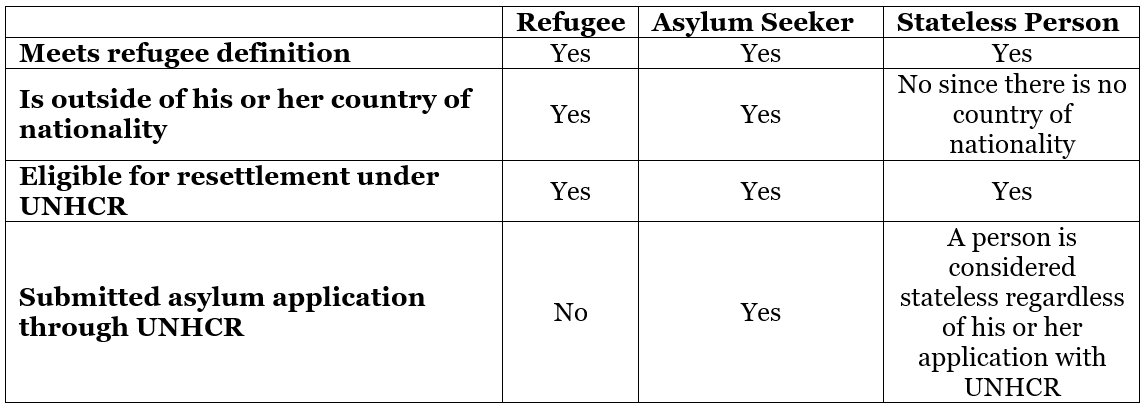 How many countries currently resettle refugees under UNHCR?
How many countries currently resettle refugees under UNHCR?
29 out of 46 resettlement countries in 2018. While 148 countries signed the 1951 Convention and/or 1967 Protocol, pledging to accept and protect refugees as they await their asylum application decisions, only 46 countries have agreed to resettle refugees, providing them with permanent status. The number of resettling countries worldwide has increased from 14 in 2005 to 46 in 2018, out of which just 29 actually resettled refugees.
How many refugees are resettled by UNHCR each year?
About 76,000 annually. Between 2009 and 2018, the resettling countries admitted an average of 76,000 refugees each year, with a peak of 126,000 in 2016 followed by a drop to a 10-year low of 55,700 in 2018. Even at the peak in 2016, the number of resettled refugees still accounted for less than one percent of the total refugee population worldwide. UNHCR mostly resettled refugees from Syria, Congo and Myanmar in 2018.
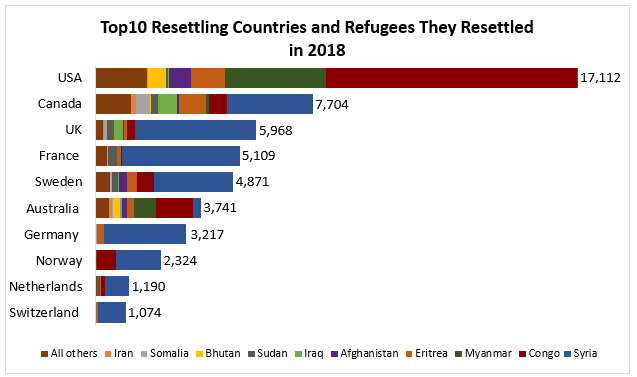
Source: https://rsq.unhcr.org/en/#oF8j
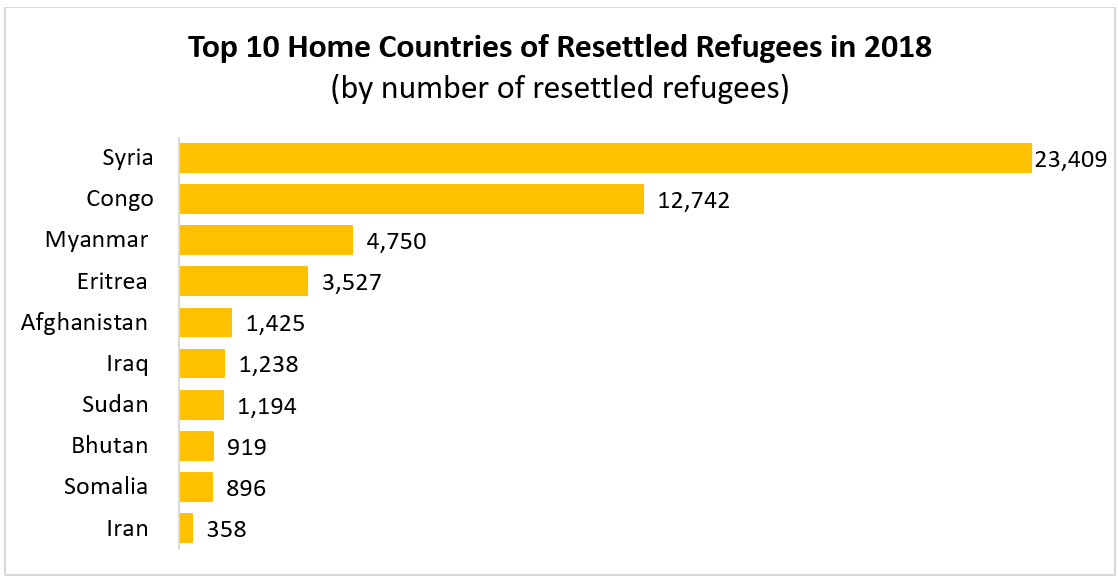
Source: https://rsq.unhcr.org/en/#coF2
How many refugees and asylum seekers exist?
Over 25 million refugees and 3 million asylum seekers existed worldwide in 2017. In 2017, there were 25.4 million refugees worldwide and 3.1 million asylum seekers. That number of refugees is a 2.9-million increase from 2016, which is the biggest increase UNHCR has ever recorded in a single year. Overall, a record 68.5 million people were forcibly displaced around the world by the end of 2017.
Where do refugees come from?
Mostly from Syria, Afghanistan, South Sudan. In 2017, more than a half of all refugees worldwide were from five countries:
Source: https://www.unhcr.org/globaltrends2017/Source: https://www.unhcr.org/globaltrends2017/
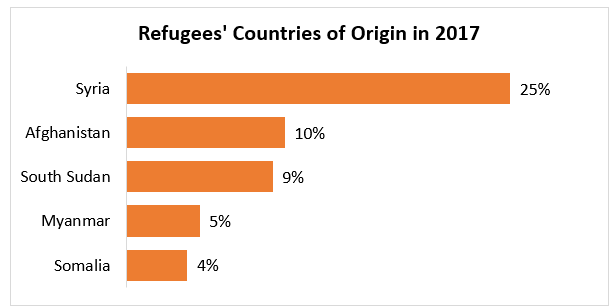 Source: https://www.unhcr.org/globaltrends2017/
Source: https://www.unhcr.org/globaltrends2017/
Which asylum countries currently host the largest number of refugees?
Mostly Turkey, Uganda and Pakistan. In 2017, the top asylum countries worldwide that hosted refugees were:
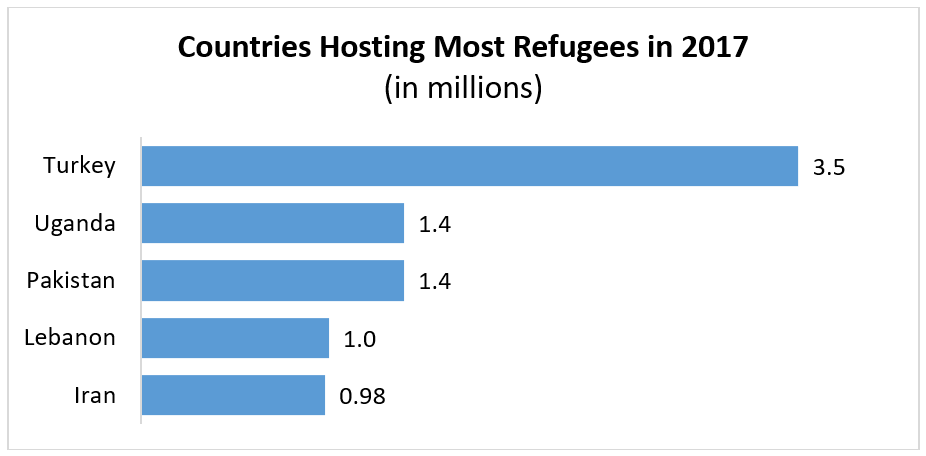 Source: https://www.unhcr.org/en-us/figures-at-a-glance.html
Source: https://www.unhcr.org/en-us/figures-at-a-glance.html
Who are internally displaced people?
Individuals, who left their homes but are still in their home country. Internally Displaced People (IDPs) are individuals, who left their homes but did not cross the border and seek safety in other towns, communities, camps, forests, and etc. in their country. IDPs account for the largest share of all forcibly displaced people worldwide, about 40 million people in total. IDPs are not protected by the international protection laws because they are still protected by their governments. Colombia, Syria, Somalia and Democratic Republic of Congo have some largest numbers of IDPs in the world.

